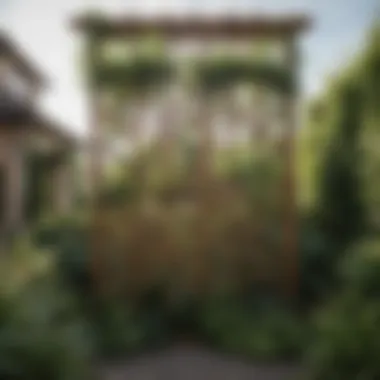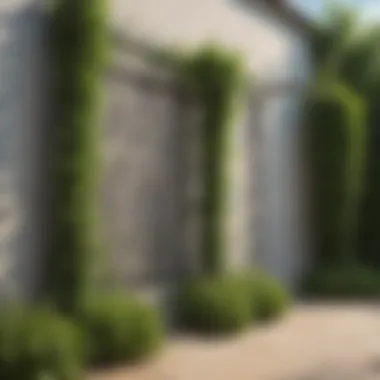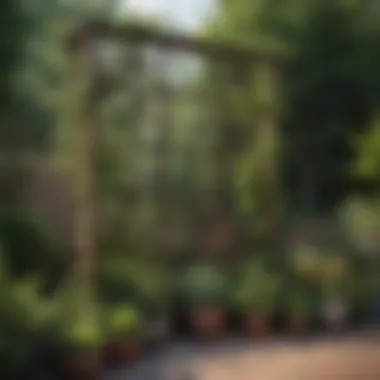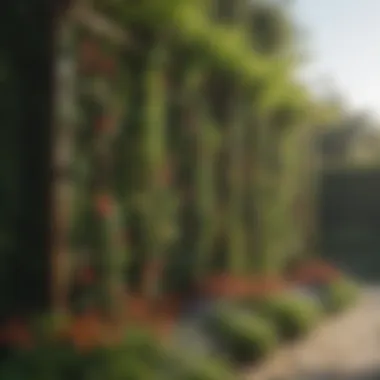Affordable Trellis Ideas to Enhance Your Garden


Intro
In the world of gardening, the use of trellises can change the way a space looks and feels. They are more than just supports for climbing plants; they enhance the overall design of the garden. This guide dives deep into budget-friendly trellis ideas that cater to different gardening styles and aesthetics. Whether you have a small balcony or a large backyard, trellises can add vertical dimension, creating a captivating visual experience. Here, we explore materials, designs, and some do-it-yourself options, ensuring that affordability remains a key focus.
Design Inspiration
Trellises serve as both functional structures and design elements. They can help to define areas in the garden or serve as backdrops for flowers and plants. When considering the design of a trellis, it is important to take cues from current gardening trends.
Materials for Trellises
The selection of materials is vital when planning your garden's trellis. Affordable choices can include:
- Wood: Treated lumber or reclaimed wood can offer a rustic look without breaking the bank.
- Metal: Lightweight metal tubing or fencing materials can create modern, durable trellises.
- Plastic: This is an inexpensive option, particularly if you are looking for less maintenance.
- Natural materials: Bamboo stakes provide a simple and eco-friendly alternative.
Each material has its own charm and robustness, which can influence the overall feel of your garden.
Practical Designs for Modern Gardens
In the quest for elegant and affordable solutions, consider designs that align with current gardening styles:
- Geometric shapes: These can add structure and visual interest. A sharply defined, rectangular trellis can contrast beautifully with soft flowers.
- Arched trellises: These afford a more romantic touch and can create a stunning entryway into a garden.
- Latticework: Allows for air circulation and light penetration, lending itself to a more natural look that's easy to DIY.
The design will ultimately reflect personal style and the mood you want to create in the garden.
The Beauty of DIY Options
Creating your own trellis can be rewarding. Not only does it allow for personalization, but it can also drastically cut costs. Some DIY projects can follow simple steps:
- Plan the size: Decide on the dimensions based on the plants being supported and the available space.
- Select materials: Make sure to gather supplies that match your budget.
- Assemble: Follow a straightforward guide or instructional video. Many online resources are available.
Many trellises can be assembled in a weekend.
Benefits of Trellises
Trellises do not just enhance the visual appeal; they also support healthy plant growth by providing structure for climbing plants.
Incorporating trellises helps to maximize space, especially in smaller gardens. They enable plants to take advantage of vertical growth, allowing for a greater variety of planting.
Epilogue
This guide presents a practical overview of affordable trellis options that can significantly enhance any garden. Through thoughtful materials selection and innovative designs, it is possible to create a vibrant garden space without overspending. Let this exploration of trellis ideas motivate you to embrace vertical gardening and its many benefits. By implementing these strategies, you ensure your garden becomes a true reflection of your style and a flourishing sanctuary.
Prologue to Trellises
Trellises offer an intriguing solution to enhance any garden space. They serve not only as structural supports for climbing plants but also as aesthetic elements that elevate the overall design of the outdoor area. In this section, we will delve into the fundamental aspects of trellises—understanding their purpose and the myriad benefits they bring to the gardening experience.
Understanding the Purpose of a Trellis
A trellis acts as a vertical framework that supports climbers and vining plants. Its primary role is to provide stability and guidance for plant growth, allowing the plants to reach upward. This vertical growth can effectively utilize limited ground space, making trellises particularly valuable in smaller gardens. By directing plant growth upwards, trellises help in maximizing sunlight exposure, which is crucial for photosynthesis.
Moreover, trellises can create defined areas within a garden. For example, a trellis can separate different garden zones or act as a beautiful backdrop for seating areas. As trellises can also be made from various materials, they can contribute to the personality and style of a garden in unique ways. They can be rustic, modern, or even sculptural, adding a layer of visual interest.
Benefits of Incorporating a Trellis in Your Garden
Adding a trellis to your garden design can yield numerous benefits, including:
- Space Optimization: By encouraging vertical growth, trellises help you make the most of limited gardening space. This is particularly useful in urban environments where ground space is at a premium.
- Improved Airflow: Climbing plants on a trellis typically receive better airflow than those growing horizontally. This can reduce disease problems commonly associated with overcrowded plants.
- Enhanced Aesthetics: Trellises can enhance the visual appeal of your garden. With flowers cascading down or climbing plants weaving around the structure, they create a dynamic and vibrant atmosphere.
- Functional Division: Trellises can be used to delineate spaces. They can define pathways, create privacy, or separate different sections of the garden.
- Support for Various Plants: Many plants, including flowers and vegetables, benefit from trellis support. This allows gardeners to explore a diverse range of plants suited for vertical growth.


"Incorporating a trellis can transform an ordinary garden into a more visually appealing and functional space."
In summary, trellises are not just practical support structures; they play a vital role in garden design and plant health. Understanding their purpose and benefits sets the stage for homeowners and gardening enthusiasts to creatively integrate trellises into their outdoor areas.
Exploring Materials for Budget-Friendly Trellises
Choosing the right materials for a trellis is crucial in enhancing the overall functionality and aesthetic of a garden. Understanding what materials are available allows homeowners to select options that not only fit their budget but also suit their design preferences. This section will delve into several materials that can be considered affordable and practical for building trellises, providing insights into their unique characteristics and benefits.
Wood as a Primary Material
Wood remains one of the most popular options for constructing trellises. Its natural look complements gardens nicely. In addition to being widely accessible, wood is relatively easy to work with for DIY projects. Affordable options include untreated pine, cedar, or even recycled pallets.
When selecting wood, it’s essential to consider weather resistance. For example, treated lumber will withstand the elements better than untreated boards. Furthermore, wood can be painted or stained to match the garden's existing design. This flexibility adds to its appeal, making it a versatile choice for many gardeners.
Metal Options for Durability
Metal trellises introduce a modern edge to garden aesthetics. Options like galvanized steel or aluminum provide durability that wood may lack. These materials can resist rust and corrosion, ensuring they last longer under adverse weather. Metal trellises can take on various designs, from intricate to minimalist, appealing to a wide variety of tastes.
While the pricing for metals can vary, many budget-friendly choices are available. If one desires a sleek look with longevity, metal can be a wise investment. It can also be painted to suit personal design preferences, allowing some creativity in outward appearance while maintaining function.
Using PVC for Lightweight Solutions
PVC is another material that deserves attention due to its lightweight nature and resistance to decay. For those who need a quick and easy setup, PVC trellises are affordable and hassle-free to install. They come pre-manufactured in various styles, which can be further decorated to fit the garden's theme.
Although some may be concerned about durability, PVC can withstand various weather conditions without rotting or rusting. Its lightweight nature makes it easy to transport and install compared to heavier materials like wood or metal. This material is an attractive option for those on a budget who don’t mind a more modern appearance in their garden.
Recycling Old Materials
Recycling old materials for trellis construction not only saves money but also promotes a sustainable approach to gardening. Salvaged wood, rusty metal rods, and even old furniture can be repurposed into unique trellis designs. The charm of using recycled items lies in their character, making each piece distinct.
Using materials that would otherwise go to waste adds a creative dimension to your garden project. Consider visiting local thrift stores, community exchanges, or salvage yards to find unexpected treasures that can be transformed into functional structures. This strategy highlights both ecological awareness and individual creativity in garden design.
"Creativity with recycled materials can yield remarkable and unique trellises."
Through careful selection, these diverse materials offer homeowners and garden enthusiasts an array of options to enrich their gardening experiences. Whether one opts for traditional wood, durable metal, lightweight PVC, or reclaimed items, the choices available can significantly impact both the functionality and aesthetics of a garden.
DIY Trellis Projects
Trellises offer an excellent opportunity to enhance one’s garden by providing both support and aesthetic appeal. DIY trellis projects encourage creativity and can drastically reduce costs compared to purchasing pre-made structures. They allow the gardener to customize designs according to personal preferences and specific gardening needs, leading to greater satisfaction. Building a trellis also fosters a sense of accomplishment, as individuals can appreciate the fruits of their labor in a flourishing garden. This section will delve into various DIY trellis projects that are accessible, affordable, and functional.
Simple Wooden Frame Trellis
A simple wooden frame trellis is one of the easiest projects to start with. It requires minimal tools and materials. The basic structure is made from wooden stakes and horizontal boards. The steps are clear:
- Gather Materials: Use untreated wood, such as cedar or pine, to avoid chemical treatments that could leach into the soil. You will need four vertical stakes and several horizontal pieces.
- Construct the Frame: Place two vertical stakes into the ground to form the height of the trellis. Attach horizontal boards across these stakes. Repeat for the other side and connect them, creating a rectangular frame.
- Secure in Place: Ensure both the vertical and horizontal pieces are sturdy. You can use screws or nails for better stability.
- Customize: Optional decorations such as paint or varnish can enhance the visual appeal.
This type of trellis not only supports climbing plants but can also serve as a decorative element in your garden.
Metal Grid Trellis Construction
A metal grid trellis is ideal for those seeking durability. Metal can withstand various weather conditions, making it a long-term investment. Here is how you can create a metal grid trellis:
- Select Your Metal: Consider using metal fencing panels or wire mesh. Both options are effective and easily found at hardware stores.
- Measure Dimensions: Measure the area where the trellis will serve. Cut the metal into desired sizes if necessary.
- Install Posts: Drive four metal posts into the ground to support your grid if using fencing panels. If using wire, secure it to existing structures, like fences or walls.
- Attach the Grid: Simply secure the wire or fence panels to the posts. Ensure they are tight and stable.
- Decorate: This trellis can remain unadorned for a sleek look or can be painted for added character.
A metal grid trellis complements a modern garden aesthetic and is particularly suited for supporting heavier plants.
Trellis from Lattice Panels
Lattice panels offer a versatile option for a DIY trellis. They provide an intriguing visual element while allowing plants to climb freely through. The process is straightforward:


- Choose Lattice Material: Wooden or vinyl lattice panels are commonly used. Wooden lattice gives a rustic feel, while vinyl is low-maintenance.
- Frame and Support: Create a frame using wood or metal stakes as anchorage for the lattice. This ensures stability.
- Attach the Lattice: Fasten the lattice panels to the frame securely. You can leave some space between the panels to allow plants to grow through.
- Finishing Touches: Stain or paint the lattice for durability and style. It's also a good opportunity to match the existing garden elements.
This trellis type is particularly suitable for flowers and fast-growing vines, transforming your garden space into a vibrant display.
Creating a Living Trellis with Plants
A living trellis not only provides support but also works harmoniously with your plants. This option captures the essence of a lush garden while serving a functional purpose:
- Select Your Plants: Choose plants like climbing roses, peas, or pole beans. Consider their growth patterns and sunlight requirements.
- Bamboo or Stakes: Use bamboo poles or other organic materials to create a trellis frame.
- Plant the Base: Insert the stakes into the ground and plant the climbing plants around the base.
- Training: As plants grow, gently train them around the framework. This can be done using garden twine or clips.
- Observation: Monitor their growth and provide supports where necessary to guide them.
Creating a living trellis is an environmentally friendly way to combine functionality with natural beauty in your garden.
DIY trellis projects allow for personalization and creativity, enabling unique garden experiences that are both enjoyable and economically feasible.
Incorporating Trellises into Your Garden Design
Incorporating trellises into your garden design is an essential aspect of creating a functional and aesthetically pleasing outdoor space. Trellises serve not only as structural supports for climbing plants but also as an effective way to enhance the overall layout of your garden. A well-placed trellis can create vertical interest, add dimension, and act as a focal point. The utilization of trellises in your garden can also help maximize space by allowing you to grow plants upwards, which is especially relevant for those with limited ground area.
Using Trellises for Vertical Gardening
Vertical gardening is a method that utilizes upward space instead of spreading plants horizontally. This is where trellises become particularly relevant. By installing trellises, you can cultivate a variety of plants, such as sweet peas, cucumbers, and indeterminate tomatoes, which benefit from climbing. Vertical gardening not only saves ground space but also improves air circulation around the plants, allowing for better growth and a lower risk of disease.
- Increased yield per square foot
- Easier harvesting at eye level
- Less strain on your back during gardening activity
In a vertical garden, a trellis acts as a division or a natural pathway, guiding the growth of plants upward, thus creating a layered effect. This method can also enhance the visual appeal of your garden by adding textures and colors that change with the seasons.
Combining Trellises with Other Structures
Trellises can synergize with existing garden elements. For example, you might place them alongside fences, walls, or garden seating, thus creating seamless transitions in your garden design. They can work in conjunction with arbors, benches, or even pathways, merging functionality with beauty.
Consider placing a trellis next to a seating area. This not only provides shade but can also give a sense of privacy when adorned with flowering vines. The contrast between solid structures and climbing plants will add depth to the overall design.
Choosing the Right Location for Maximum Impact
The placement of a trellis is crucial for its role in your garden design. It should enhance the overall aesthetic without overshadowing other elements. When selecting a location, think about factors like sunlight, airflow, and views.
- Sunlight: Ensure that the plants chosen for the trellis receive adequate sunlight. For sun-loving plants, position the trellis in a spot that receives at least six hours of direct sunlight daily.
- Visibility: Position the trellis in a way that it is visible from key viewpoints in your garden. A well-placed trellis can be a striking focal point.
- Accessibility: Ensure that the area around the trellis is accessible for maintenance and harvesting purposes.
It's important to consider these aspects carefully to ensure that your trellis not only serves its purpose but also enhances the beauty of your garden.
The strategic incorporation of trellises can transform an ordinary garden into an extraordinary space, while maximizing utility and aesthetic appeal.
Plant Selections for Trellis Support
Choosing the right plants to support your trellis can significantly influence the overall success of your garden design. The plants that grow on and around trellises not only provide vertical interest but also contribute to the garden's aesthetic appeal. Whether one seeks vibrant blooms or productive harvests, the selection of appropriate climbing plants can enhance both form and function. Key considerations include the plant's growth habits, maintenance needs, and compatibility with the local climate. This section explores various plant options that thrive when trained on trellises, thereby improving the garden's visual and productive aspects.
Climbing Flowers
Climbing flowers are a staple choice for any trellis garden. They can create stunning vertical displays, adding color and texture to any structure. Some popular options include:
- Clematis: Known for its large, showy flowers, clematis prefers full sun and well-drained soil. Different varieties bloom at various times, allowing for prolonged flowering throughout the season.
- Honeysuckle: This vine produces sweet-scented flowers that attract pollinators. Moreover, it grows rapidly, covering trellises with lush foliage.
- Morning Glory: An annual vine, morning glories are easy to grow and can bloom in various colors. However, they do require full sun and a good support structure due to their fast growth.
When selecting climbing flowers, consider factors like their bloom times and color schemes to create a harmonious look.
Vegetables That Climb
Utilizing trellises for vegetables is an efficient way to maximize space in the garden. Climbing vegetables allow for larger planting densities while increasing air circulation and sunlight exposure, which helps prevent fungal diseases. Notable climbing vegetables include:


- Pole Beans: Unlike bush beans, pole beans thrive on support and can reach heights of up to six feet or more. They are relatively easy to grow and produce abundant yields.
- Cucumbers: When trained on a trellis, cucumbers can produce straighter fruits and are easier to harvest. They prefer a warm growing environment and will need adequate watering during the hot months.
- Peas: Climbing peas, such as sugar snap or snow peas, can utilize trellises for support. They grow quickly in cool weather and are an excellent choice for spring gardens.
Incorporating climbing vegetables can lead not only to more efficient space usage but also to a diverse harvest each season.
Fruits and Berries Suitable for Trellises
Fruits, especially berries and certain types of vines, are ideal for trellis systems. They provide both beauty and bounty, making them a delightful addition to gardens. Worthy mentions include:
- Grapes: Vigorously growing, grapevines can cover trellises quickly. They need ample sun and well-drained soil to produce sweet fruits.
- Raspberries: Erecting trellises for raspberries can keep the canes upright, making them easier to manage and harvest. They typically bear fruit in the summer.
- Kiwi: Hardy kiwi vines are a unique addition to gardens. They can be productive on a trellis and require a sunny location with well-draining soil.
With careful plant selection, your trellis can transform from a mere structure into a flourishing part of your garden ecosystem.
Maintaining Your Trellis
Maintaining your trellis is crucial for ensuring its longevity and functionality within your garden. Over time, trellises can face various challenges, from natural wear and tear to the impact of plant growth. Regular maintenance not only enhances the trellis’s aesthetic appeal but also ensures that it effectively supports the climbing plants throughout their growth cycle. The following key elements provide a clear framework for proper trellis maintenance.
Routine Inspections for Structural Integrity
Conducting routine inspections is vital for assessing the structural integrity of your trellis. Regular checks will help identify any potential weaknesses, such as loose screws or rotting wood. These physical assessments should occur at least once a season, particularly after storms or heavy winds.
Examine the following aspects during your inspections:
- Look for signs of damage like cracks or bends.
- Ensure that supporting elements, like posts and anchors, are secure.
- Check for rust or corrosion if your trellis is made of metal.
Addressing issues promptly is key. For example, re-tightening loose screws or treating rust can prevent more significant problems later. A well-maintained trellis is more likely to support the plants as intended, leading to healthier growth and blooms.
Pruning and Training Plants on the Trellis
Pruning and training the plants to grow effectively on the trellis is essential for both plant health and trellis function. As climbing plants grow, they can become unruly if not appropriately guided. Pruning involves removing excess growth and dead or unhealthy branches. This method not only encourages more vigorous growth but also prevents overcrowding, which can impair air circulation.
While training plants, consider the following:
- Use soft ties to guide the plants along the trellis framework.
- Regularly check growth patterns to redirect vines as needed.
- Remove any plant material that obstructs the trellis or threatens its stability.
Consistent training ensures that plants achieve full coverage on the trellis, improving your garden’s vertical aesthetics. Moreover, it enhances the plants’ exposure to sunlight and air, thereby promoting overall health.
Weatherproofing for Longevity
Weatherproofing is an essential part of maintaining a trellis. Exposure to the elements, such as rain, snow, and sunlight, can gradually deteriorate materials. By taking steps to weatherproof your trellis, you can significantly extend its lifespan.
Consider these weatherproofing techniques:
- Apply a water-repellent sealant to wooden trellises to prevent rotting.
- For metal trellises, use a rust-proof coating to safeguard against moisture.
- Monitor for cracks or splits and fill them with appropriate materials to prevent damage from expanding moisture and freezing.
Implementing these strategies can mitigate damage and is an investment in the durability of your overall garden structure.
Maintaining a trellis is not just about aesthetics; it significantly impacts the health of the plants it supports. Proper upkeep enables both the plant and the trellis to thrive in harmony.
End
Summarizing Costs vs. Aesthetic Value
When considering the installation of trellises, a fundamental concern often revolves around balancing costs with the aesthetic benefits they offer. An effective trellis does not always equate to high expenditure. In fact, numerous budget-friendly materials, such as wood, metal, or even repurposed items, can be transformed into elegant structures. Investing thoughtfully allows for an improved visual appeal while remaining economical.
Some cost-effective trellis ideas include:
- Wooden trellises made from untreated wood can be painted or stained to complement the garden's color scheme.
- Metal grids are versatile and can be coated to match the existing decor, providing durability at a lower price point.
- Recycled materials like old doors or window frames can also enhance garden aesthetics creatively.
Ultimately, the right combination of cost-efficient resources leads to unique designs that enhance the garden's charm.
Final Tips for Successful Trellis Installation
For those looking to install a trellis, several considerations can elevate the success of your project:
- Site Selection: Choose a spot that maximizes sunlight while considering how the trellis interacts with existing plants.
- Structural Stability: Assess the materials' durability. Ensure the trellis is secured into the ground to withstand weather changes.
- Plant Compatibility: Not every plant will flourish on every type of trellis. Undertanding which plants to use is essential to ensure health and visual appeal.
In summary, with the right approach, installing a trellis becomes not just a functional necessity but also an opportunity to amplify the garden's beauty. Engaging in this process fosters a deeper connection with your garden and rewards you with a satisfying visual outcome.















